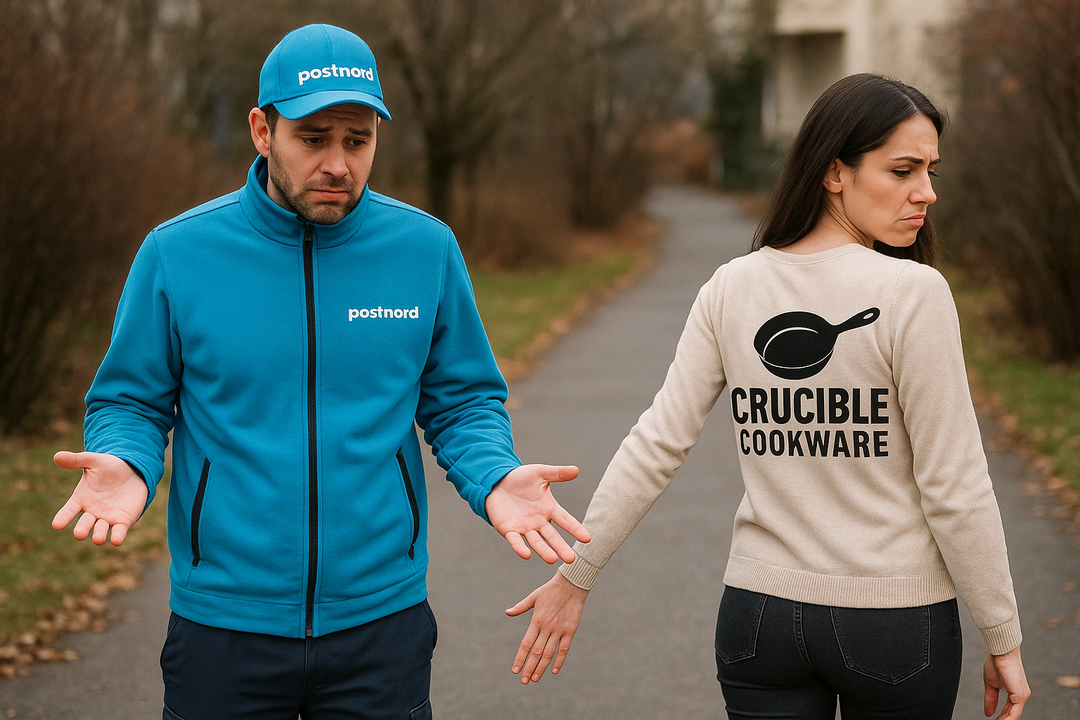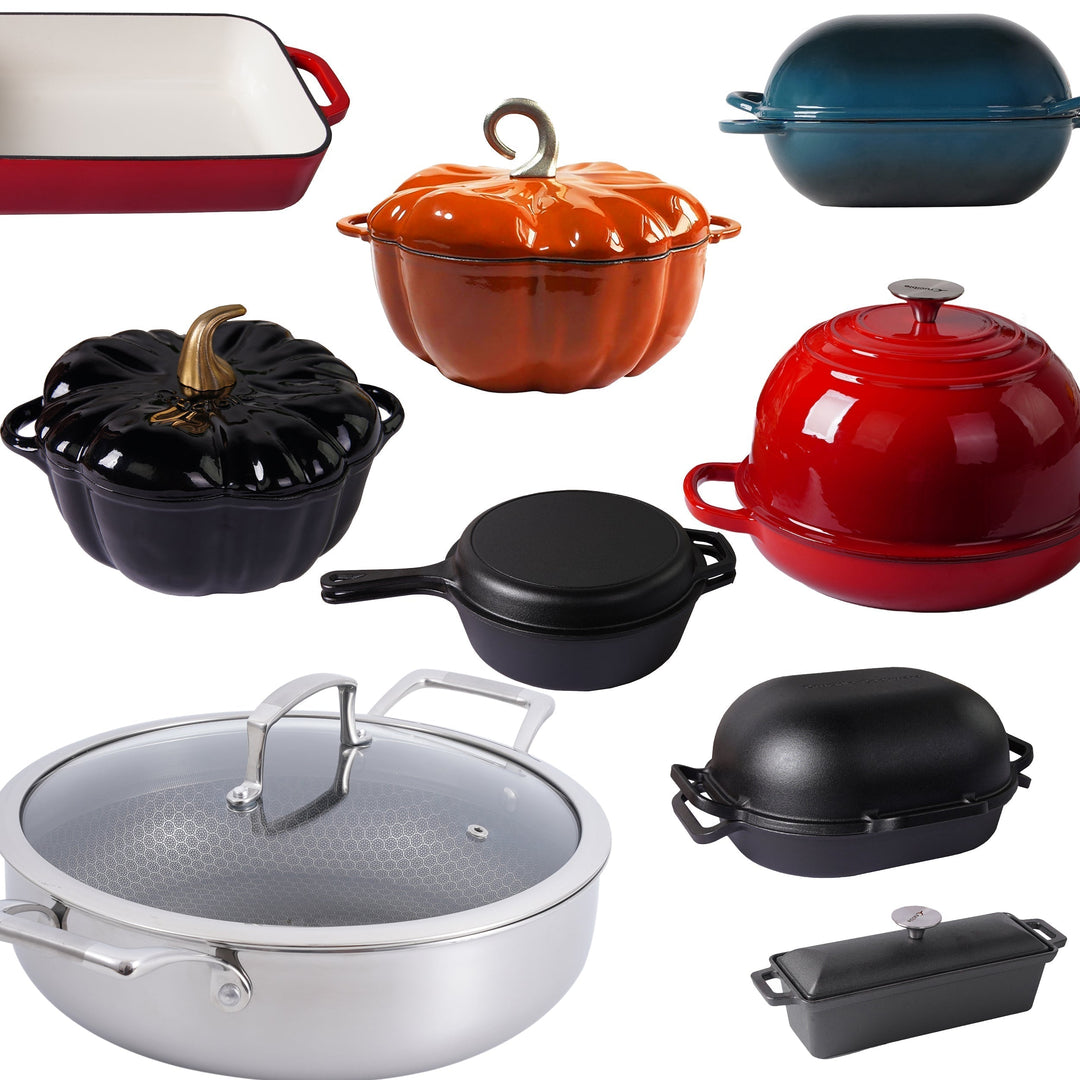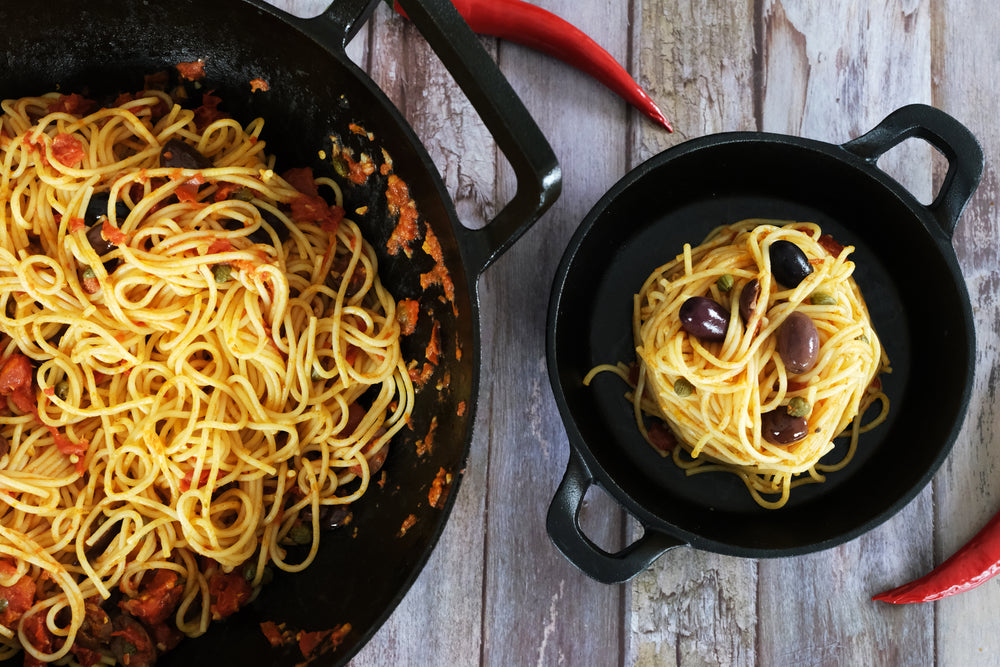Hoe kies je de juiste pan voor elk recept: een complete gids voor het selecteren van kookgerei

Of je nu een beginner in de keuken bent of een ervaren chef, een van de meest voorkomende vragen is: “Welke pan moet ik gebruiken?” Met zoveel opties beschikbaar—gietijzer, roestvrij staal, anti-aanbak en meer—kan het overweldigend zijn om te beslissen welke het beste is voor elk gerecht. De juiste kookgerei kiezen kan je kookervaring verbeteren en je helpen de beste smaken en texturen te bereiken. In deze gids bespreken we de verschillende soorten pannen, hun ideale toepassingen en hoe je ze onderhoudt, zodat je nooit meer twijfelt over je pan keuze!
1. Gietijzer: De robuuste krachtpatser
Beste voor: Dichtschroeien, sauteren, bakken, braden en langzaam garen.
Gietijzeren pannen worden geprezen om hun veelzijdigheid, duurzaamheid en uitzonderlijke warmtebehoud. Ze kunnen naadloos van het fornuis naar de oven, waardoor ze ideaal zijn voor recepten die bruinen op het fornuis en afmaken in de oven vereisen, zoals skillet maïsbrood of in de pan dichtgeschroeide steak.

-
Wanneer te gebruiken:
- Vlees dichtschroeien: De hoge, gelijkmatige hitte creëert een perfecte korst op steaks, koteletten of kipdijen.
- Groenten roosteren: Karameliseert groenten gelijkmatig zonder te verbranden.
- Brood of desserts bakken: Gebruik het voor recepten zoals skillet brownies of maïsbrood voor een heerlijke knapperige korst.
-
Verzorgingstips:
- Was met warm water (geen zeep) en een zachte borstel; vermijd schuursponsjes.
- Droog grondig en inbrand met een lichte laag olie om het anti-aanbakoppervlak te behouden en roestvorming te voorkomen.
-
Receptsuggestie: Gietijzeren skillet pizza—De warmteopslag van de pan geeft de korst een knapperige bodem terwijl de toppings mals en gesmolten blijven.
2. Roestvrij staal: De alleskunner
Beste voor: Bruinen, afblussen, koken en sudderen.
Roestvrijstalen pannen zijn favoriet bij veel professionele koks vanwege hun duurzaamheid en snelle reactie op temperatuurveranderingen. Ze verdelen de warmte gelijkmatig, waardoor ze perfect zijn voor delicate sauzen, vlees bruinen of pasta koken. Zonder coating reageert roestvrij staal niet met zure ingrediënten zoals tomaten of wijn, wat zorgt voor schone, pure smaken.
-
Wanneer te gebruiken:
- Vlees bruinen: Geweldig voor het opbouwen van aanbaksel (die heerlijke bruine stukjes die zich onderin vormen) voor rijke pannensauzen.
- Afblussen: Het aanbaksel komt gemakkelijk los wanneer je vloeistof toevoegt, wat de smaken van jus of reducties versterkt.
- Koken en sudderen: Werkt goed voor het maken van bouillons, soepen of grote hoeveelheden pasta.
-
Verzorgingstips:
- Gebruik een beetje olie of boter om plakken te voorkomen.
- Voor hardnekkige resten, weken in warm zeepsop of gebruik een roestvrijstalen reiniger.
-
Receptsuggestie: Kip Piccata—Bak de kip in de pan, blus daarna af met citroensap en witte wijn om een zijdezachte saus te maken.
3. Anti-aanbak: Het ontbijt essentieel
Beste voor: Eieren, pannenkoeken, delicate vis en vetarm koken.
Anti-aanbakpannen staan bekend om hun gemakkelijk loslatende oppervlak, waardoor ze de beste keuze zijn voor het koken van voedsel dat snel blijft plakken. Omdat ze minimale olie vereisen, zijn anti-aanbakpannen ook uitstekend voor gezondere kookopties.
-
Wanneer te gebruiken:
- Eieren en pannenkoeken bakken: Bereik de perfecte draai zonder de dooier te breken of de pannenkoek te scheuren.
- Delicate vis koken: Voorkomt dat visfilets uit elkaar vallen.
- Vetarm koken: Een uitstekende keuze wanneer je de hoeveelheid olie of boter wilt verminderen.
-
Verzorgingstips:
- Gebruik alleen siliconen, houten of plastic keukengerei om krassen op de coating te voorkomen.
- Vermijd hoge hitte; houd het op middelhoog of laag om de levensduur van de pan te verlengen.
- Was met de hand met een zachte spons; vermijd de vaatwasser.
-
Receptsuggestie: Fluffy Omelet met Verse Kruiden—Kook op laag vuur voor een perfect gevouwen omelet die gemakkelijk uit de pan glijdt.
4. Geëmailleerd Gietijzer: De Veelzijdige Schoonheid
Beste voor: Langzaam koken, stoven, stoofschotels en ovenschotels.
Geëmailleerd gietijzer biedt de warmtebehoud en duurzaamheid van traditioneel gietijzer, maar met een niet-reactieve emaille coating die gemakkelijk schoon te maken is. Dit maakt het ideaal voor langzaam gegaarde gerechten zoals stoofschotels, braises en ovenschotels die profiteren van langzame, gelijkmatige bereiding.

-
Wanneer te gebruiken:
- Stoven: De constante warmte zorgt ervoor dat taaiere stukken vlees afbreken en mals worden.
- Soepen en stoofschotels maken: Houdt warmte goed vast voor langdurig sudderen.
- Ovenschotels bakken: Gaat van fornuis naar oven zonder van pan te wisselen.
-
Verzorgingstips:
- Laat de pan afkoelen voordat je hem schoonmaakt om beschadiging van het email te voorkomen.
- Gebruik zachte sponzen en milde afwasmiddel; vermijd schurende pads.
-
Receptsuggestie: Beef Bourguignon—Deze klassieke Franse stoofpot is perfect voor geëmailleerd gietijzer, waardoor smaken kunnen samensmelten bij een lage, langzame suddering.
5. Koper: Het Responsieve Keukengereedschap
Beste voor: Precies koken, sauzen, candy-making, en sauteren.
Koperen kookgerei reageert zeer snel op temperatuurveranderingen, waardoor het ideaal is voor recepten die precisie vereisen. Het warmt snel op en koelt snel af, wat je uitstekende controle over het kookproces geeft. Koper is vaak bekleed met roestvrij staal of tin om reacties met zure voedingsmiddelen te voorkomen.
-
Wanneer te gebruiken:
- Sauzen en karamels maken: De precieze temperatuurregeling voorkomt aanbranden.
- Groenten sauteren: Kookt groenten gelijkmatig en snel zonder te gaar te worden.
- Candy-making: Perfect voor suikerwerk, waarbij consistente temperaturen essentieel zijn.
-
Verzorgingstips:
- Reinig met een mengsel van citroen en zout om het heldere, glanzende uiterlijk te behouden.
- Vermijd het gebruik voor sterk zure of alkalische voedingsmiddelen als de bekleding beschadigd is.
-
Receptsuggestie: Hollandaisesaus—Gebruik de snelle warmte-reactie van de pan om een fluweelzachte, romige hollandaisesaus te maken zonder te schiften.
6. Koolstofstaal: De keuze van de professional
Beste voor: Aanbraden, roerbakken en het verkrijgen van een knapperige korst.
Koolstofstalen pannen combineren de beste eigenschappen van gietijzer en roestvrij staal: ze zijn lichtgewicht, warmen snel op en ontwikkelen na verloop van tijd een anti-aanbak patina. Ze worden vaak gebruikt in professionele keukens vanwege hun veelzijdigheid en duurzaamheid.

-
Wanneer te gebruiken:
- Hoge temperatuur aanbraden: Ontwikkelt een uitstekende korst op vlees.
- Roerbakken: Gebruik het in plaats van een wok voor snel koken op hoge temperatuur.
- Crepes maken: Het gladde oppervlak is perfect voor dun, delicaat beslag.
-
Verzorgingstips:
- Brand de pan regelmatig in zoals gietijzer.
- Vermijd in het begin zure voedingsmiddelen, omdat ze het inbranden kunnen aantasten.
-
Receptsuggestie: Roergebakken rundvlees en broccoli—De hoge hitte van de pan maakt snel koken mogelijk, waardoor de knapperigheid van de groenten en de malsheid van het vlees behouden blijven.
De juiste pan kiezen: Belangrijke punten
- Voor koken op hoge temperatuur en een natuurlijke anti-aanbaklaag, kies gietijzer of koolstofstaal.
- Voor delicate gerechten zoals eieren of vis is anti-aanbak je beste keuze.
- Voor langzaam garen en stoven, kies geëmailleerd gietijzer.
- Voor precieze controle, investeer in koperen kookgerei.
- Voor veelzijdig, dagelijks koken, gebruik roestvrij staal.
Met de juiste pan in de hand wordt elk gerecht leuker om te bereiden en te eten. Experimenteer met verschillende soorten, en je ontdekt snel je favorieten voor diverse technieken en recepten. Veel kookplezier!
















Laat een reactie achter